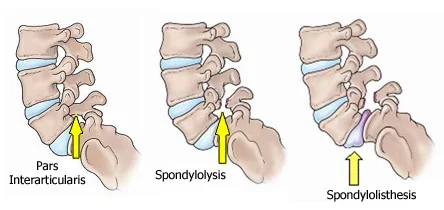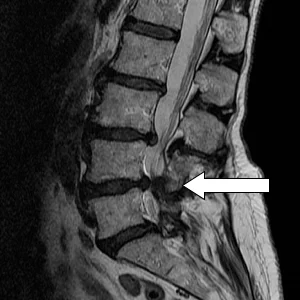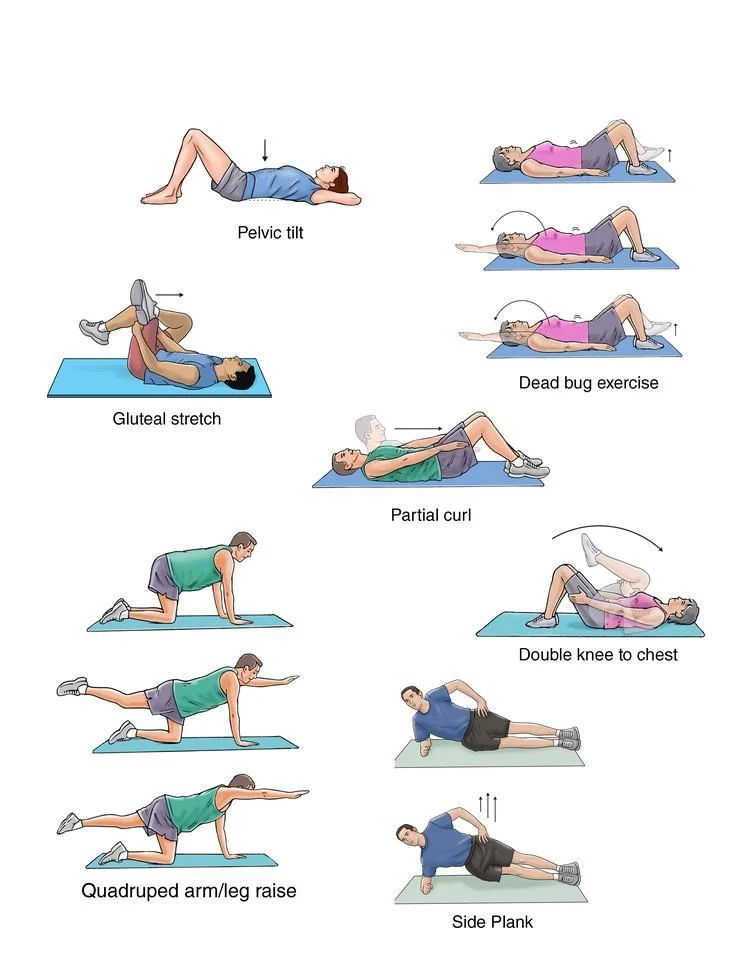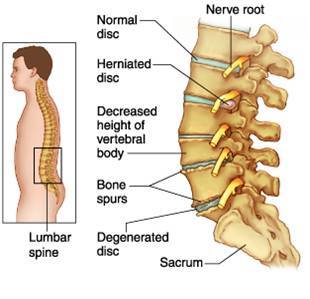Lumbar Spondylosis: Physiotherapy Treatment
DEFINITION AND INTRODUCTION:
Lumbar spondylosis is a degenerative condition that affects the lower back, specifically the lumbar spine. It is characterized by the deterioration of the spinal discs, the development of bone spurs, and the narrowing of the spinal canal. This can lead to various symptoms such as back pain, stiffness, limited mobility, and radiating pain in the legs.
- Lumbar spondylosis is a medical condition in which chronic pain is experienced by the patient in the lower back. This is due to compression of the intervertebral discs, which can leads to displacement of the vertebral bodies.
- Lumbar Spondylosis is a condition associated with degenerative changes in the intervertebral discs and facet joints.
- Spondylosis, also known as spinal osteoarthritis, can affect the lumbar, thoracic, and/or the cervical regions of the spine. Although aging is the primary cause, the location and rate of degeneration is individual.
- As the lumbar discs and associated ligaments undergo aging, the disc spaces frequently narrow. Thickening of the ligaments that surround the disc and those that surround the facet joints develops.
- These ligamentous thickening may eventually become calcified. Compromise of the spinal canal or of the openings through which the spinal nerves leave the spinal canal can occur.
- Spondylosis often affects the lumbar spine in people over the age of 40. Pain and morning stiffness are common complaints.
- Usually multiple levels are involved (eg, more than one vertebrae). The lumbar spine carries most of the body’s weight. Therefore, when degenerative forces compromise its structural integrity, symptoms including pain may accompany activity.
- Movement stimulates pain fibers in the annulus fibrosus and facet joints. Sitting for prolonged periods of time may cause pain and other symptoms due to pressure on the lumbar vertebrae. Repetitive movements such as lifting and bending (eg, manual labor) may increase pain.
- Lumbar spondylosis encompasses lumbar disc bulges, herniations, facet joint degeneration, and vertebral bony overgrowths (osteophytes). Degenerative changes, including osteophyte formation, increase with age but are often asymptomatic.
- Disc herniation is symptomatic when it causes nerve root compression and spinal stenosis. Common symptoms include low back pain, sciatica, and restriction in back movement. Treatment is usually conservative, although surgery is indicated for spinal cord compression or intractable pain. Relapse is common, with patients experiencing episodic back pain.
PATHOPHYSIOLOGY:

- The degenerative effects of ageing can cause the fibers of the discs to weaken, causing wear and tear. Constant wear and tear and injury to the joints of the vertebrae causes inflammation in the joints. Degeneration of the discs leads to the formation of mineral deposits within the discs.
- The water content of the center of the disc decreases with age and as a result the discs become hard, stiff, and decreased in size. This, in turn, results in strain on all the surrounding joints and tissues, causing the sensation of stiffness. With less water in the center of the discs, they have decreased shock absorbing qualities.
- An increased risk of disc herniation also results, which is when the disc abnormally protrudes from its normal position.
- Each vertebral body contains four joints that act as hinges. These hinges are known as facet joints or zygapophyseal joints.
- The job of the facet joins is to allow the spinal column to flex, extend, and rotate. The bones of the facet joints are covered with cartilage (a type of flexible tissue) known as end plates.
- The job of the end plates is to attach the disks to the vertebrae and to supply nutrients to the disc. When the facet joints degenerate, the size of the end plates can decrease and stiffen. Movement can stimulate pain fibers in the facet joints and annulus fibrosus. Furthermore, the vertebral bone underneath the end plates can become thick and hard.
- Degenerative disease can cause ligaments to lose their strength. A ligament is a tough band of tissue that attaches to joint bones. In the spine, ligaments connect spinal structures such as vertebrae and prevent them from moving too much. In degenerative spondylosis, one of the main ligaments (known as the ligamentum flavum) can thicken or buckle, making it weaken.
- Knobby, abnormal bone growths (known as bone spurs or osteophytes) can form in the vertebrae. These changes can also cause osteoarthritis. Osteoarthritis is a disease of the joints that is made worse by stress.
- In more severe cases, these bones spurs can compress nerves coming out of the spinal cord and/or decreased blood supply to the vertebrae. Areas of the body supplied by these nerves may become painful or develop loss of sensation and function.
CAUSES AND RISK FACTORS:
- Age: As a person ages the healing ability of the body decreases and developing arthritis at that time can make the disease progress much faster. Persons over 40 years of age are more prone to developing lumbar spondylosis.
- Obesity: Overweight puts excess load on the joints as the lumbar region carries most of the body’s weight, making a person prone to lumbar spondylosis.
- Sitting for prolonged periods: Sitting in one position for prolonged time which puts pressure on the lumbar vertebrae.
- Prior injury: Trauma makes a person more susceptible to developing lumbar spondylosis.
- Heredity or Family history.
- Strong physical activities.
- Lifting of heavy objects.
- External injury.
- Genetic issues.
- Smoking.
SIGNS AND SYMPTOMS:
- Symptoms of lumbar spondylosis follow those associated with each of the various aspects of the disorder: disc herniation, sciatica, spinal stenosis, degenerative spondylolisthesis, and degenerative scoliosis.
- Pain associated with disc degeneration may be felt locally in the back or at a distance away. This is called referred pain, as the pain is not felt at its site of origin.
- Lower back arthritis may be felt as pain in the buttock, hips, groin, and thighs. As with spinal stenosis or disc herniation in the lumbar region, it is important to be aware of any bowel or bladder incontinence, or numbness in the perianal area.
- These signs and symptoms could represent an important massive nerve compression needing surgical intervention (cauda equina syndrome).
- Pain and stiffness in the lower back.
- Pins and needles or other abnormal sensation in the legs.
- Muscle weakness in the legs.
- Bladder incontinence.
DIAGNOSIS
PHYSICAL EXAMINATION:
- A thorough physical examination reveals much about the patient’s health and general fitness. The physical part of the exam includes a review of the patient’s medical and family history.
- Often laboratory tests such as complete blood count and urinalysis are ordered. The physical exam may include:
- Palpation (exam by touch) determines spinal abnormalities, areas of tenderness, and muscle spasms.
- Range of Motion measures the degree to which a patient can perform movement of flexion, extension, lateral bending, and spinal rotation.
- A neurologic evaluation assesses the patient’s symptoms including pain, numbness, paresthesias (e.g. tingling), extremity sensation and motor function, muscle spasm, weakness, and bowel/bladder changes. Particular attention may be given to the extremities.
- Either a CT Scan or MRI study may be required if there is evidence of neurologic dysfunction.
Imaging Studies

- Radiographs (X-rays) may indicate loss of vertebral disc height and the presence of osteophytes, but is not as useful as a CT Scan or MRI.
- CT Scan may help reveal bony changes sometimes associated with spondylosis.
- MRI is a sensitive imaging tool capable of revealing disc, ligament, and nerve abnormalities.
- Discography seeks to reproduce the patient’s symptoms to identify the anatomical source of pain. Facet blocks work in a similar manner. Both are considered controversial.
- The physician compares the patient’s symptoms to the findings to formulate a diagnosis and treatment plan.
- The results from the examination provide a baseline from which the physician can monitor and measure the patient’s progress.
TREATMENTS:
- Each patient is treated differently for arthritis depending on their individual condition. In the early stages lifestyle modifications or medicines are used for treatment and surgery is needed only if these measures are ineffective.
- Modifying lifestyle including occupational changes if doing manual labor, losing weight and quitting smoking.
- Physical therapy which teaches the patient to strengthen the paravertebral and abdominal muscles which lend support to the spine. General exercises which help build flexibility, increase range of motion and strength.
- A corset or a brace could be used to provide support; cervical collars may be used to alleviate pain by restricting movement.
- Rest combined with anti-inflammatory medications, muscle relaxants, and analgesics.
- More powerful anti-inflammatory drugs like corticosteroids can also be injected into the joints to help control pain.
- Hot or cold packs on the affected area, ultrasound, and electric stimulation are some of the other treatments which are used.
- In more severe cases surgical methods are advised to improve pain and increase motion.
PHYSIOTHERAPY MANAGEMENT:

- Goals:
- Relief of pain.
- Restoration of movements.
- Strengthening of muscles.
- Education of posture.
- Analysis of precipitating factors to reduce recurrence of the patient’s problems.
- Management of acute symptoms:
- Rest and Support- With acute joint symptoms, a lumbar corset may be helpful to provide rest to inflamed facet joints. When acute symptoms decrease, discontinue corset by gradually increasing the time without the corset.
- Often the most comfortable position is flexion, esp. if there are neurologic signs due to decrease in the foraminal space from joint swelling or osteophytes.
- Education of posture- Head, neck and shoulders should be supported by the back rest of chair with a small pillow in the lumbar spine, the feet supported and the arm resting on armrests or on a pillow in the lap.
- Modalities- Hot or cold packs on the affected area, ultrasound, and electric stimulation are some of the other treatments that are used to decrease pain and reduce muscle spasms.
- Relaxation- by soft tissue techniques. Teach self-relaxation techniques, e.g. deep breathing exercises physiological relaxation (Laura Mitchell method), and hydrotherapy.
- Traction- Gentle intermittent joint distraction and gliding techniques may inhibit painful muscle responses and provide synovial fluid movement within the joint for healing.
- Gentle ROM within the limits of pain.
- Management of subacute and chronic phases:
- Increase ROM- Free active exercises of the lumbar spine. Pelvic tilting forward, backward in crook lying, quadruped, sitting, and standing.
- Mobilization- Restoration of intersegmental mobility by accessory pressure enables the patient to regain full functional pain-free movement.
- Stretching exercises.
- Strengthening exercises.
- Posture correction.
- Physiotherapy Rehabilitation:
- Pre and post-surgical care of all conditions.
- Balance/vertigo rehabilitation.
- Postural training.
- Arthritis management.
- Back rehabilitation.
- Joint pain management.
- Headache management.
- Manual therapy/mcKenzie treatment.
- Spinal stabilization.
- Muscle and ligament strains and sprains.
- Myofascial release.
- Auto accident injuries.
- Work injuries.
BRACING FOR SPONDYLOSIS:
- Thoraco-lumbo-sacral orthosis (TLSO).
- Lumbo sacral orthosis(LSO).
- Corset/soft brace.
How to Prevent Lumbar Spondylosis?
While it may not be possible to completely prevent lumbar spondylosis, there are several measures you can take to reduce the risk or slow down its progression. Here are some preventive strategies:
- Maintain a healthy weight: Excess weight puts additional stress on your spine, increasing the risk of spondylosis. Keep your Body weight within normal range through regular exercise and a balanced diet.
- Practice good posture: Avoid prolonged periods of sitting or standing in one position. Use ergonomic chairs and adjust your workstation to maintain proper posture. When lifting weight, use your legs and not your back.
- Exercise regularly: Engage in exercises that strengthen the core muscles, as they provide support to the spine. Low-impact activities like swimming, walking, and yoga can help improve flexibility and strengthen the back muscles.
- Take frequent breaks: If your job involves long hours of sitting or standing, make sure to take regular breaks and stretch your muscles. Change positions frequently to avoid prolonged strain on the spine.
- Use proper body mechanics: When performing physical activities or lifting heavy objects, use proper body mechanics. Bend your knees, keep the object close to your body, and avoid twisting motions.
- Avoid repetitive movements: Repetitive activities or movements can contribute to spine degeneration. If your job involves repetitive motions, take breaks or modify your work routine to minimize the strain on your spine.
- Quit smoking: Smoking reduces blood flow to the spinal discs, impairing their nutrition and accelerating degeneration.
- Maintain a healthy lifestyle: Adopting a healthy lifestyle that includes a balanced diet, regular exercise, adequate sleep, and stress management can contribute to overall spinal health.
Remember, these preventive measures may help reduce the risk of developing lumbar spondylosis or slow down its progression, but they cannot guarantee complete prevention. If you experience persistent back pain or any symptoms related to the spine, it’s essential to consult a healthcare professional for an accurate diagnosis and appropriate treatment.




Nice locating this page
Nice Information Thank You
Very educative